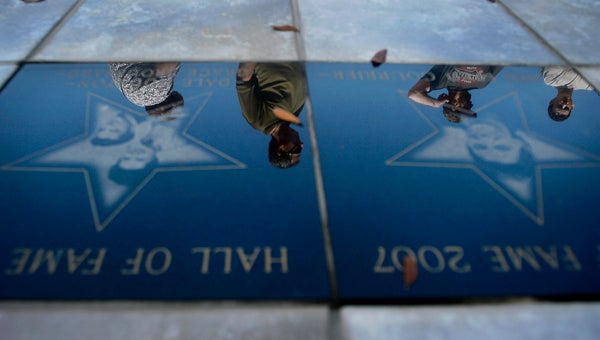Romney, Santorum seesaw in Iowa
Published 11:31 pm Tuesday, January 3, 2012
DES MOINES, Iowa (AP) — Rick Santorum and Mitt Romney waged a seesaw battle for supremacy in Iowa’s Republican presidential caucuses late Tuesday night, a dramatic opening round for the campaign to pick a challenger to President Barack Obama.
Texas Gov. Rick Perry, a leader in opinion polls at one point, finished a distant fifth and said he would return to his home state “to determine whether there is a path forward” for his White House aspirations.
Texas Rep. Ron Paul finished third, not far behind the front-runners.
Returns from 97 percent of the state’s precincts showed Santorum, a former Pennsylvania senator, and Romney, a former governor of Massachusetts, in a near dead heat, a fitting conclusion to a race as jumbled as any since Iowa gained the lead-off position in presidential campaigns four decades ago.
Regardless of the outcome, there was enough for both to claim a victory — Romney as the man to beat for the party’s nomination and Santorum as the leader among those struggling to emerge as the former governor’s unvarnished conservative rival in the primaries yet to come.
New Hampshire votes next, and Romney is heavily favored in the first-in-the-nation primary on Jan. 10. South Carolina on Jan. 21 figures to be a tougher test, the first contest in the South and a state that is part of the Republican political base.
Former House Speaker Newt Gingrich was headed for a fourth-place finish.
Returns from 1,715 of 1,774 precincts showed Santorum with 24.6 percent, Romney with 24.6 percent and Paul with 21.3 percent. Santorum had 29,210 votes, Romney 29,173 and Paul 25,307.
Former House Speaker Newt Gingrich had 13 percent, followed by Texas Gov. Rick Perry, 10 percent, and Minnesota Rep. Michele Bachmann with 5 percent.
No matter how close the final results in Iowa, there were no plans for a recount.
Doug Heye, a spokesman for the state party, said the ballots were counted under the supervision of campaign representatives who certified the totals. He said the numbers were double-checked when they were reported to state officials and there was no reason to check them again.
“On to New Hampshire,” Gingrich said to the cheers of his supporters, vowing to carry on his campaign no matter the Iowa outcome.
The former speaker led in the pre-caucus polls as recently as a few weeks ago, only to fall under the weight of attack ads run by a super PAC run by allies of Romney.
Paul, too, said he was looking forward to the nation’s first primary in a week’s time, telling supporters his was one of two campaigns with the resources to do the distance. “There’s going to be an election up in New Hampshire, and believe me this momentum is going to continue and this movement is going to continue and we are going to keep scoring,” he told supporters.
The Texas lawmaker didn’t say so, but the other campaign already built for a long campaign was Romney’s. The former Massachusetts governor was closeted with aides and his family as he sweated out the caucus count in a state that humbled him four years ago.
This time, win or lose, he appeared destined to draw a smaller share of the vote than the 25.2 percent he did then.
Each of the three in the top tier strove to create a distinct identity and brought a different style to the race.
Santorum, the former Pennsylvania senator, ran the old-fashioned way, spending parts or all of 250 days campaigning in the state in hopes of emerging b(euro) ” as he did in the campaign’s final week b(euro) ” as the preferred conservative alternative to Romney.
Romney, the former Massachusetts governor, brought organization and money to the table, and was aided by deep-pocketed allies who ran television commercials attacking former House Speaker Newt Gingrich and others. That allowed Romney to take the high road in person, running as a former businessman who knew how to create jobs and defeat Obama.
Paul, the Texas congressman, was something of a blend of the two approaches, with money and organization. He drew on the support of younger caucus-goers with a libertarian-leaning approach that included a call to legalize marijuana and bring home U.S. troops from overseas.
Whichever among the three eventually finished ahead, it appeared likely the winner’s share of the vote would be a record low for GOP caucuses in the state. Former Sen. Bob Dole had 26.3 percent support in 1996, when he won.
This time, the economy and the federal budget deficit were top issues, judged more important than abortion or health care, according to a survey of early caucus-goers.
Nearly a third of those surveyed said they most wanted a candidate who could defeat Obama, and those favored Romney as a group. Paul and Santorum split the votes of the one in four who called the selection of a true conservative their top priority, and the former Pennsylvania senator also made a strong showing among those who said their top priority was a candidate with a strong moral character as well as among late deciders.
Paul had an edge among younger and first-time caucus goers.
The survey by Edison Media Research for The Associated Press and television networks was based on interviews with 1,737 people arriving at 40 precinct caucuses across the state.
Obama was unopposed for the Democratic nomination. Even so, his re-election campaign set up eight offices across Iowa, made hundreds of thousands of calls to voters and arranged a video conference with caucus night supporters.
“This time out is going to be in some ways more important than the first time,” the president told Democrats across the state. “Change is never easy.”
The Iowa caucuses’ outsized importance was underscored by the estimated $13 million in television advertising by the candidates and so-called super PACs as well as thousands of campaign stops designed to sway 100,000 or so voters.
Ironically, the weak economy that has made Obama appear vulnerable nationally was muted as an issue here. Despite areas of economic distress, the farm economy is strong. Iowa’s unemployment in November was 5.7 percent, sixth lowest in the country and well below the national reading of 8.6 percent.
Despite its importance as the lead-off state, Iowa has a decidedly uneven record when it comes to predicting national winners. It sent Obama on his way in 2008, but eventual Republican nominee John McCain finished a distant fourth here to former Arkansas Gov. Mike Huckabee.
Even before Tuesday night’s results were known, this year’s Republican hopefuls were turning their attention to the next contests. Romney’s campaign purchased time to run television ads in Florida, where balloting is three weeks distant, while Perry put down money in South Carolina.
Aides said the Gingrich campaign had purchased a full-page newspaper ad in New Hampshire for Wednesday morning calling Romney a “Timid Massachusetts Moderate.”
Romney, who finished second in Iowa in 2008 despite a costly effort, initially campaigned cautiously this time around.
But he barnstormed extensively across the state in the race’s final days in pursuit of a first-place finish, running as a conservative businessman with the skills to fix the economy and as the challenger with the best chance to defeat Obama.
Santorum, Gingrich, Perry and Bachmann argued that Romney wasn’t nearly conservative enough on the economy and social issues such as abortion. They vied for months to emerge as the alternative to the former Massachusetts governor.
Paul’s libertarian-leaning views set him apart, and he hoped that might be enough to claim victory in a six-way race where no one broke away from the pack.
Unlike in a primary, in which voting occurs over hours, the 809 Iowa caucuses were meetings in which Republicans gathered for an evening of politics. Each presidential candidate was entitled to have a supporter deliver a speech on his or her behalf before straw ballots were taken.
Under party rules, caucus results have no control over the allocation of Iowa’s 25 delegates to the Republican National Convention. The Associated Press uses the caucus outcome to calculate the number each candidate would win if his support remained unchanged in the pre-convention months.
The race in Iowa came to be defined by its unpredictability as the months rolled by and nationally televised candidate debates piled up.
Bachmann gained early momentum on the strength of a victory in a summertime straw poll and a feisty debate performance.
But she quickly faltered when Perry joined the race and overshadowed her as the 10-year governor of Texas with deep-pocketed supporters and an unbroken record of electoral success at home.
Perry’s rise lasted only as long as a couple of debates b(euro) ” including one where he memorably was unable to recall the third of three federal agencies he wanted to abolish.
Next up was Herman Cain, a black former businessman who improbably shot to the top of the polls in a party that draws its support chiefly from white voters. He suspended his candidacy a few weeks later, after a woman said she and he had carried on a long-term extra-marital affair.
Gingrich rode the next surge in the polls, a remarkable comeback for a man whose campaign had imploded earlier in 2011 when most of his aides quit in frustration. But his rise lasted only until a super PAC that supports Romney began attacking him on television.
Enter Paul, and Santorum, both campaigning widely across the state and hoping to have the last say.
Democrats watched carefully in a state that has swung between the two parties in recent presidential elections.
It was Iowa that launched Obama on the way to the White House four years ago when he won a convincing victory in the caucuses.
The state’s lead-off spot has been a fixture for decades. Democrats moved the caucuses up to early January in 1972, and Republicans followed suit four years later.
———
David Espo reported from Washington.






